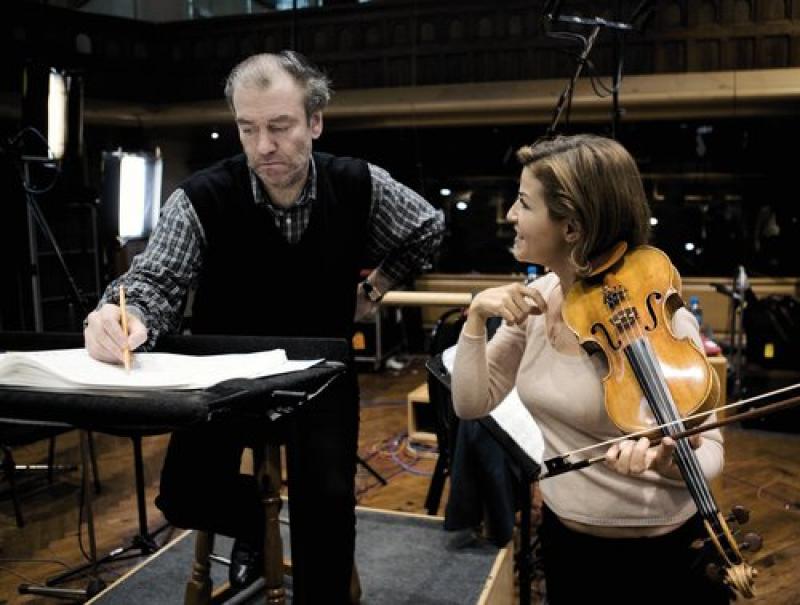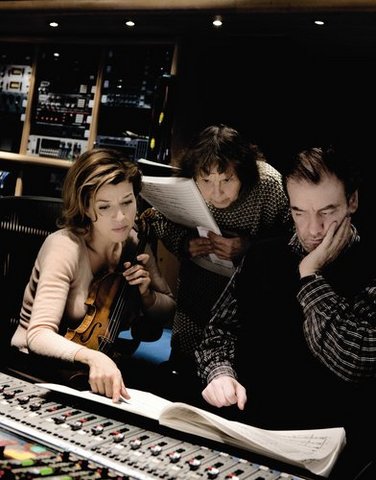Mutter, London Symphony Orchestra, Gergiev, Barbican Hall | reviews, news & interviews
Mutter, London Symphony Orchestra, Gergiev, Barbican Hall
Mutter, London Symphony Orchestra, Gergiev, Barbican Hall
A hard-hitting double bill of two Russian masterworks over 50 years apart

Praise be, or slava if you prefer, to Valery Gergiev for honouring new Russian music alongside his hallmark interpretations - ever evolving or dangerously volatile according to taste – of Prokofiev, Shostakovich and Stravinsky. Last LSO season featured some of the less than inspired recent works Rodion Shchedrin has been dredging by the yard. Yet few would begrudge the palm of deep and original musical thought to this past week’s heroine, Sofia Gubaidulina.
In tempus praesens bends the "present time" it purports to be all about with unstable interchanges between soloist and kaleidoscopic, unpredictable orchestral groups. The courage of Mutter's ardent solo violin at the start with its intense, human vibrato sometimes takes a battering from the heavier scoring - though the singular colour of the three Wagner tubas fleetingly present couldn't really be detected - and several times is silenced by the oracular "enough" of a giant tam-tam, struck by a player with his back to the massive instrument.
 An intensely beautiful, chorale-like weave between soloist and woodwind is brushed aside by manic flights and monster-toybox rattles taking up where Shostakovich, another great innovator with the percussion battery, left off; a relentless three-note string tattoo urged by Gergiev with his usual insistence on fullness of sound finally ushers in a big cadenza before a final metaphysical soaring.
An intensely beautiful, chorale-like weave between soloist and woodwind is brushed aside by manic flights and monster-toybox rattles taking up where Shostakovich, another great innovator with the percussion battery, left off; a relentless three-note string tattoo urged by Gergiev with his usual insistence on fullness of sound finally ushers in a big cadenza before a final metaphysical soaring.
One Russian cellist told me he saw the end of Prokofiev's Symphony-Concerto as the Russian image of the soul squeezing in to heaven through the eye of a needle, as it were, and that's how Gubaidulina's strange adventure (the composer pictured above with Mutter and Gergiev) seemed to end. And adventure it was, moving forward through space - or certainly seeming to do so through Mutter's urgent interaction with Gergiev's ever-vivid LSO - in a way that few contemporary pieces genuinely achieve, and stocked with enough ideas for half a dozen works by a lesser composer. This is a concerto that's here to stay.
Collectively, the woodwind plumb unison depth of tone that few achieve in Shostakovich's whirlwind Scherzo
Nearly 60 years on, there's no doubt about the status of Shostakovich's 10th Symphony, one of the most monumentally entrenched in the repertoire out of the 15. Gergiev's latest way with a work he knows inside out no longer favours much brooding atmosphere - slow introduction to the finale excepted - nor colossal tragedy, only a mastery that understands how every corner must be turned, and how to communicate that turning with the finest nuance to the players.
Collectively, the woodwind plumb unison depth of tone that few achieve in the whirlwind Scherzo - which may, or may not, be an evocation of Stalin's terror years looking back from the temporary release of 1953 - but they’re equally impressive as individuals. If you had to slice into the interpretation for the truest evidence of Gergiev’s moulding, it would probably be for the combination of ravishing tone colours from flute and softest pizzicato in the limping waltz that ever so cautiously lifts the laments of the first movement.
Yet every solo brought its fine-etched personality, culminating in the personal pleas of Nora Cismondi's oboe and Rachel Gough's bassoon, both superlative, before the clouds lift for what in this case was an unequivocally springy final romp. As the years pass, we come to hear Shostakovich's symphonies as flawless constructions not necessarily freighted with the horrors of his times, and in that respect Gergiev seems to have loosened up as much as many of his younger fellow conductors. But then next time his Shostakovich 10 will probably sound different again.
Share this article
The future of Arts Journalism
You can stop theartsdesk.com closing!
We urgently need financing to survive. Our fundraising drive has thus far raised £49,000 but we need to reach £100,000 or we will be forced to close. Please contribute here: https://gofund.me/c3f6033d
And if you can forward this information to anyone who might assist, we’d be grateful.

Subscribe to theartsdesk.com
Thank you for continuing to read our work on theartsdesk.com. For unlimited access to every article in its entirety, including our archive of more than 15,000 pieces, we're asking for £5 per month or £40 per year. We feel it's a very good deal, and hope you do too.
To take a subscription now simply click here.
And if you're looking for that extra gift for a friend or family member, why not treat them to a theartsdesk.com gift subscription?
more Classical music
 Echo Vocal Ensemble, Latto, Union Chapel review - eclectic choral programme garlanded with dance
Beautiful singing at the heart of an imaginative and stylistically varied concert
Echo Vocal Ensemble, Latto, Union Chapel review - eclectic choral programme garlanded with dance
Beautiful singing at the heart of an imaginative and stylistically varied concert
 Scott, Irish Baroque Orchestra, Whelan, RIAM, Dublin review - towards a Mozart masterpiece
Characteristic joy and enlightenment from this team, but a valveless horn brings problems
Scott, Irish Baroque Orchestra, Whelan, RIAM, Dublin review - towards a Mozart masterpiece
Characteristic joy and enlightenment from this team, but a valveless horn brings problems
 Classical CDs: Voice flutes, flugelhorns and froth
Baroque sonatas, English orchestral music and an emotionally-charged vocal recital
Classical CDs: Voice flutes, flugelhorns and froth
Baroque sonatas, English orchestral music and an emotionally-charged vocal recital
 Kanneh-Mason, Britten Sinfonia, Shave, Milton Court - a grin and a big beaming smile
A pair of striking contemporary pieces alongside two old favourites
Kanneh-Mason, Britten Sinfonia, Shave, Milton Court - a grin and a big beaming smile
A pair of striking contemporary pieces alongside two old favourites
 theartsdesk at the New Ross Piano Festival - Finghin Collins’ musical rainbow
From revelatory Bach played with astounding maturity by a 22 year old to four-hand jazz
theartsdesk at the New Ross Piano Festival - Finghin Collins’ musical rainbow
From revelatory Bach played with astounding maturity by a 22 year old to four-hand jazz
 First Person: Manchester Camerata's Head of Artistic Planning Clara Marshall Cawley on questioning the status quo
Five days of free events with all sorts of audiences around Manchester starts tomorrow
First Person: Manchester Camerata's Head of Artistic Planning Clara Marshall Cawley on questioning the status quo
Five days of free events with all sorts of audiences around Manchester starts tomorrow
 Goldscheider, Brother Tree Sound, Kings Place review - music of hope from a young composer
Unusual combination of horn, strings and electronics makes for some intriguing listening
Goldscheider, Brother Tree Sound, Kings Place review - music of hope from a young composer
Unusual combination of horn, strings and electronics makes for some intriguing listening
 theartsdesk Q&A: composer Donghoon Shin on his new concerto for pianist Seong-Jin Cho
Classical music makes its debut at London's K-Music Festival
theartsdesk Q&A: composer Donghoon Shin on his new concerto for pianist Seong-Jin Cho
Classical music makes its debut at London's K-Music Festival
 Helleur-Simcock, Hallé, Wong, Bridgewater Hall, Manchester review - moving lyricism in Elgar’s concerto
Season opener brings lyrical beauty, crisp confidence and a proper Romantic wallow
Helleur-Simcock, Hallé, Wong, Bridgewater Hall, Manchester review - moving lyricism in Elgar’s concerto
Season opener brings lyrical beauty, crisp confidence and a proper Romantic wallow
 Kohout, Spence, Braun, Manchester Camerata, Huth, RNCM, Manchester review - joy, insight, imagination and unanimity
Celebration of the past with stars of the future at the Royal Northern College
Kohout, Spence, Braun, Manchester Camerata, Huth, RNCM, Manchester review - joy, insight, imagination and unanimity
Celebration of the past with stars of the future at the Royal Northern College

Add comment